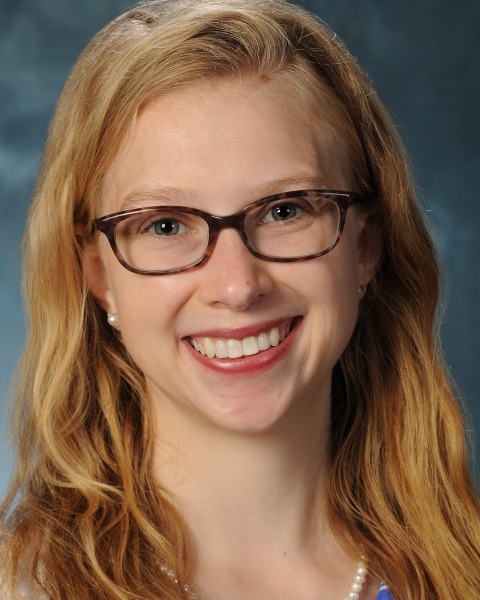Back
Poster Session C - Monday Afternoon
C0707 - Use of EUS to Characterize a Rare Gastric Tumor with EWSR1-CREM Fusion
Monday, October 24, 2022
3:00 PM – 5:00 PM ET
Location: Crown Ballroom

MariaLisa Itzoe, DO, MPH
University of Pennsylvania
Philadelphia, PA
Presenting Author(s)
Introduction: The discussion of abdominal epithelioid neoplasms with EWSR1/FUS-CREB fusion has emerged in the literature. Though precise classification is unclear, these tumors have features of mesothelioma and angiomatoid fibrous histiocytoma (AFH). We describe the case of a male with persistent abdominal pain found to have a gastric lesion characterized on EUS that required surgical resection. Histology and molecular/cytogenetic studies revealed an EWSR1-CREM fusion making this one of only two reported gastric tumors of this kind.
Case Description/Methods: A 47-year-old male with medical history of asthma, GERD, IBS, and anxiety presented with six months of epigastric discomfort worsened by eating.
On exam, he had a soft non-distended abdomen with diffuse left-sided tenderness. Labs were unremarkable. CT Abdomen showed a mass extending from the lateral wall of the stomach fundus. EUS characterized it as a solid, heterogeneous, and multicystic lesion that appeared to originate from the muscularis propria. It measured 7.6x5.3 cm with well-defined borders, subjected to transgastric FNA/FNB (Figure 1). EUS cytology showed tumor cells positive for SMA, negative for C-KIT, DOG1. Biopsy showed sheets of epithelioid cells with vesicular nuclei and clear to eosinophilic cytoplasm without necrosis. Patient underwent partial gastrectomy.
Pathology revealed an epithelioid tumor involving the gastric wall and serosa. It displayed mesothelial and AFH features by immunohistochemistry and morphology, respectively. FISH showed an EWSR1 translocation and RNA fusion panel confirmed an EWSR1-CREM fusion.
Since surgical resection, the patient’s symptoms have improved to date. He is being followed by a multidisciplinary team without adjuvant therapy as use of radiation or chemotherapy in this tumor entity has not been defined. CT scans are planned for monitoring since there is no data on risk of recurrence.
Discussion: A recently described group of tumors referred to by one paper as ‘malignant epithelioid neoplasms with a predilection for mesothelial-lined cavities’ harbor a fusion of EWSR1/FUS and CREM/CREB. While the majority of such newly reported tumors have occurred intra-abdominally, our case appears to be only the second found in the stomach. Given the growing number of such discovered neoplasms, this tumor etiology should be included in the differential for intra-abdominal masses. EUS plays an important role in distinguishing this malignancy from other intramural tumors.
Case Description/Methods: A 47-year-old male with medical history of asthma, GERD, IBS, and anxiety presented with six months of epigastric discomfort worsened by eating.
On exam, he had a soft non-distended abdomen with diffuse left-sided tenderness. Labs were unremarkable. CT Abdomen showed a mass extending from the lateral wall of the stomach fundus. EUS characterized it as a solid, heterogeneous, and multicystic lesion that appeared to originate from the muscularis propria. It measured 7.6x5.3 cm with well-defined borders, subjected to transgastric FNA/FNB (Figure 1). EUS cytology showed tumor cells positive for SMA, negative for C-KIT, DOG1. Biopsy showed sheets of epithelioid cells with vesicular nuclei and clear to eosinophilic cytoplasm without necrosis. Patient underwent partial gastrectomy.
Pathology revealed an epithelioid tumor involving the gastric wall and serosa. It displayed mesothelial and AFH features by immunohistochemistry and morphology, respectively. FISH showed an EWSR1 translocation and RNA fusion panel confirmed an EWSR1-CREM fusion.
Since surgical resection, the patient’s symptoms have improved to date. He is being followed by a multidisciplinary team without adjuvant therapy as use of radiation or chemotherapy in this tumor entity has not been defined. CT scans are planned for monitoring since there is no data on risk of recurrence.
Discussion: A recently described group of tumors referred to by one paper as ‘malignant epithelioid neoplasms with a predilection for mesothelial-lined cavities’ harbor a fusion of EWSR1/FUS and CREM/CREB. While the majority of such newly reported tumors have occurred intra-abdominally, our case appears to be only the second found in the stomach. Given the growing number of such discovered neoplasms, this tumor etiology should be included in the differential for intra-abdominal masses. EUS plays an important role in distinguishing this malignancy from other intramural tumors.

